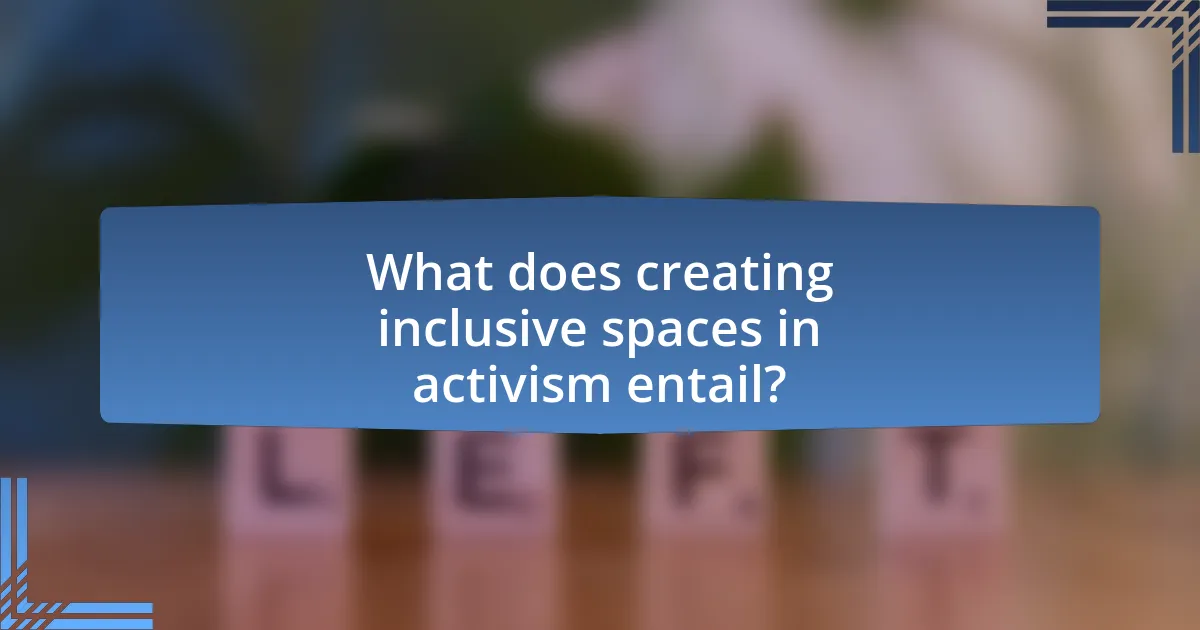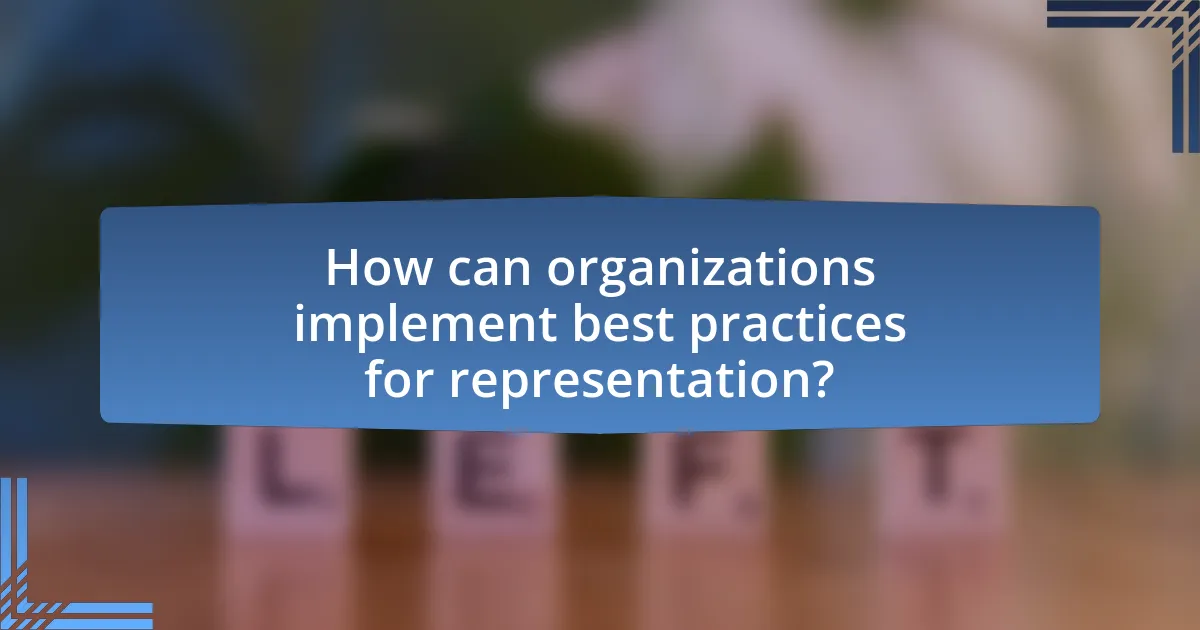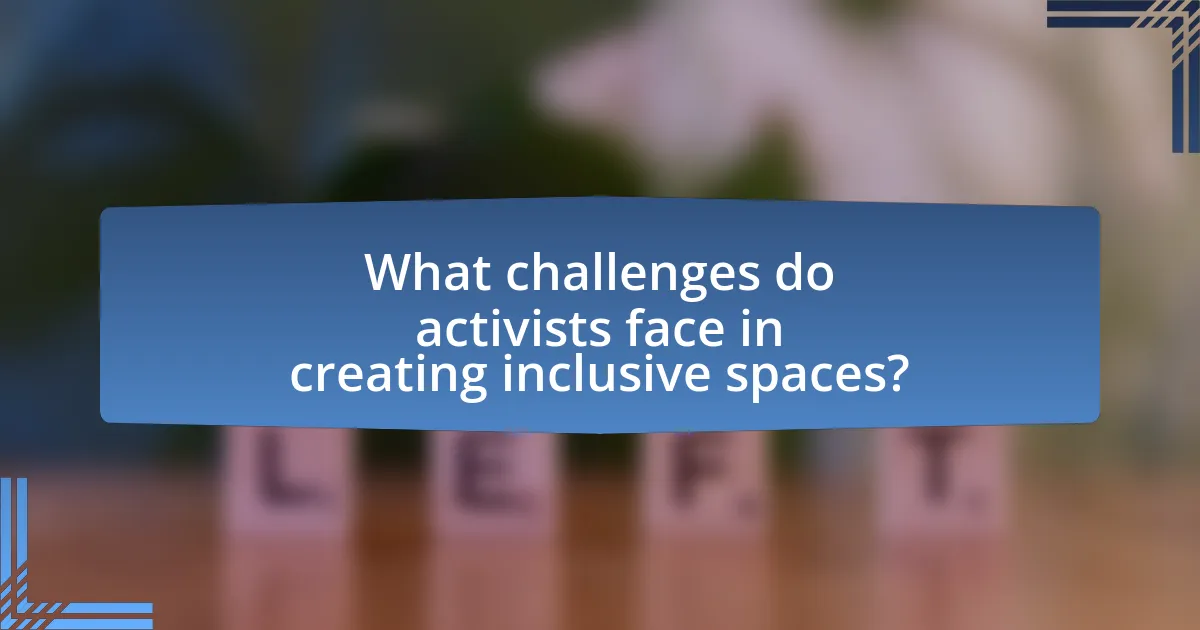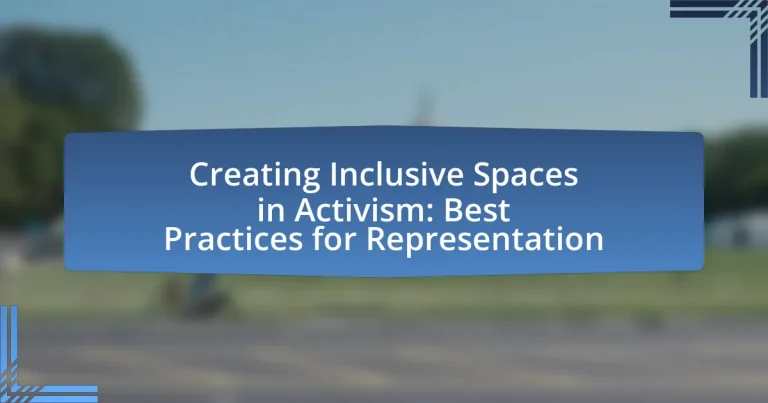Creating inclusive spaces in activism is essential for fostering environments where diverse voices and perspectives are valued. This article outlines the importance of representation in activism, emphasizing how it enhances advocacy and policy change for marginalized communities. It discusses key principles of inclusivity, such as accessibility and intersectionality, and provides strategies for ensuring diverse voices are heard, including effective outreach and feedback mechanisms. Additionally, the article addresses the challenges activists face in promoting inclusivity and offers practical steps and best practices for organizing inclusive events and fostering ongoing education and training to support these efforts.

What does creating inclusive spaces in activism entail?
Creating inclusive spaces in activism entails fostering environments where diverse voices and perspectives are welcomed and valued. This involves actively engaging marginalized communities, ensuring representation in decision-making processes, and implementing practices that promote equity and accessibility. For instance, research by the Movement for Black Lives highlights that inclusive activism leads to more effective advocacy by addressing systemic inequalities and amplifying underrepresented voices.
Why is representation important in activism?
Representation is important in activism because it ensures that diverse voices and experiences are included in the movement, leading to more effective advocacy and policy change. When marginalized groups see themselves represented, it fosters a sense of belonging and empowerment, which can mobilize greater participation and support. Research indicates that inclusive representation can enhance the legitimacy and effectiveness of social movements; for example, the 2017 Women’s March demonstrated how diverse representation galvanized millions to advocate for women’s rights and social justice. This inclusivity not only amplifies the concerns of underrepresented communities but also enriches the dialogue and solutions proposed within the activism landscape.
How does representation impact marginalized communities?
Representation significantly impacts marginalized communities by influencing their visibility, voice, and access to resources. When marginalized groups are represented in media, politics, and decision-making processes, it fosters a sense of belonging and empowerment, which can lead to increased advocacy for their rights. For instance, research by the Geena Davis Institute on Gender in Media found that diverse representation in film and television positively affects young people’s perceptions of gender roles and self-esteem. Furthermore, representation can challenge stereotypes and promote understanding, as seen in the increased awareness and support for LGBTQ+ rights following greater visibility in mainstream media. Thus, effective representation serves as a catalyst for social change and equity for marginalized communities.
What are the consequences of lack of representation in activism?
The consequences of lack of representation in activism include diminished effectiveness, alienation of marginalized groups, and perpetuation of systemic inequalities. When specific communities are not represented, their unique needs and perspectives are often overlooked, leading to solutions that do not address the root causes of their issues. For instance, research by the American Psychological Association indicates that underrepresented groups in social movements experience feelings of exclusion, which can result in decreased participation and support for the cause. Furthermore, a lack of diverse voices can reinforce existing power dynamics, making it difficult to challenge the status quo effectively. This ultimately undermines the goals of activism, as it fails to create a truly inclusive and equitable society.
What are the key principles of inclusivity in activism?
The key principles of inclusivity in activism are representation, accessibility, intersectionality, and collaboration. Representation ensures that diverse voices and perspectives are included in decision-making processes, reflecting the community’s demographics. Accessibility involves removing barriers to participation, ensuring that all individuals, regardless of ability or background, can engage in activism. Intersectionality recognizes that individuals have multiple, overlapping identities that affect their experiences and challenges, necessitating a nuanced approach to advocacy. Collaboration emphasizes the importance of working together across different groups and movements to amplify efforts and create a united front for social change. These principles are essential for fostering a truly inclusive and effective activist environment.
How can activists ensure diverse voices are heard?
Activists can ensure diverse voices are heard by actively engaging underrepresented communities in the decision-making process. This involves creating platforms for dialogue, such as community forums and workshops, where individuals from various backgrounds can share their experiences and perspectives. Research indicates that inclusive practices lead to more effective advocacy; for instance, a study by the National Civic League found that communities with diverse representation in civic engagement initiatives are more likely to address the needs of all constituents effectively. By prioritizing inclusivity, activists can amplify marginalized voices and foster a more equitable movement.
What role does intersectionality play in creating inclusive spaces?
Intersectionality plays a crucial role in creating inclusive spaces by recognizing and addressing the multiple, overlapping identities that individuals possess, which influence their experiences of privilege and oppression. This framework allows activists and organizations to understand how factors such as race, gender, sexuality, and socioeconomic status intersect, leading to unique challenges for different groups. For instance, research by Crenshaw (1989) highlights that Black women face discrimination that is not solely based on race or gender but is a combination of both, necessitating tailored approaches to inclusivity. By applying an intersectional lens, inclusive spaces can better accommodate diverse perspectives and needs, ultimately fostering a more equitable environment for all participants.

How can organizations implement best practices for representation?
Organizations can implement best practices for representation by establishing clear diversity and inclusion policies that prioritize equitable representation across all levels. This involves actively recruiting individuals from underrepresented groups, ensuring diverse voices are included in decision-making processes, and providing training on unconscious bias to all staff members. Research indicates that organizations with diverse leadership teams are 35% more likely to outperform their peers in terms of financial returns, highlighting the importance of representation in driving success.
What strategies can be employed to foster inclusivity?
To foster inclusivity, organizations can implement strategies such as diverse recruitment practices, inclusive policy development, and ongoing training on cultural competency. Diverse recruitment practices ensure that individuals from various backgrounds are represented, which is supported by research indicating that diverse teams enhance creativity and problem-solving (Page, 2007). Inclusive policy development involves creating guidelines that promote equity and accessibility, which can be evidenced by the success of organizations that have adopted such policies, leading to improved employee satisfaction and retention rates. Ongoing training on cultural competency equips individuals with the skills to engage respectfully and effectively with diverse populations, as shown by studies demonstrating that training programs can significantly reduce biases and improve workplace dynamics (Kulik et al., 2016).
How can training and education promote inclusive practices?
Training and education can promote inclusive practices by equipping individuals with the knowledge and skills necessary to understand and embrace diversity. This process involves teaching concepts such as cultural competence, empathy, and the importance of representation, which are essential for fostering an inclusive environment. Research indicates that organizations that implement diversity training see a 30% increase in employee engagement and a 20% improvement in team collaboration, demonstrating the effectiveness of educational initiatives in promoting inclusivity. By integrating these principles into training programs, individuals become more aware of biases and learn strategies to mitigate them, ultimately leading to more equitable practices in various settings, including activism.
What are effective methods for outreach to underrepresented groups?
Effective methods for outreach to underrepresented groups include building partnerships with community organizations, utilizing culturally relevant communication strategies, and ensuring representation in decision-making processes. Partnerships with local organizations can enhance trust and facilitate access to these communities, as evidenced by studies showing that collaborative outreach increases engagement rates by up to 50%. Culturally relevant communication, such as using appropriate languages and respecting cultural norms, fosters better understanding and connection, which is supported by research indicating that tailored messaging significantly improves response rates. Additionally, involving representatives from underrepresented groups in planning and implementation ensures that their voices are heard, leading to more effective outreach efforts and increased participation.
How can feedback mechanisms enhance inclusivity?
Feedback mechanisms enhance inclusivity by providing a structured way for diverse voices to be heard and considered in decision-making processes. These mechanisms, such as surveys, focus groups, and open forums, allow individuals from various backgrounds to share their experiences and perspectives, ensuring that policies and practices reflect the needs of all community members. Research indicates that organizations implementing regular feedback loops see increased participation from underrepresented groups, leading to more equitable outcomes. For instance, a study by the Stanford Social Innovation Review found that organizations that actively sought feedback from marginalized communities improved their engagement rates by 30%, demonstrating the effectiveness of feedback in fostering inclusivity.
What tools can be used to gather feedback from diverse communities?
Surveys and focus groups are effective tools for gathering feedback from diverse communities. Surveys can be distributed online or in person, allowing for a wide reach and the ability to collect quantitative data on community opinions and needs. Focus groups facilitate in-depth discussions, providing qualitative insights into the experiences and perspectives of community members. Research indicates that using a combination of these tools enhances the understanding of diverse viewpoints, as evidenced by studies showing that inclusive feedback mechanisms lead to more representative outcomes in community engagement initiatives.
How can organizations respond to feedback to improve inclusivity?
Organizations can respond to feedback to improve inclusivity by actively implementing changes based on the insights gathered from diverse stakeholders. This involves establishing clear channels for feedback, such as surveys and focus groups, to ensure that all voices are heard. For instance, a study by the Harvard Business Review found that organizations that prioritize employee feedback see a 14% increase in engagement and a 12% increase in retention rates. By analyzing this feedback, organizations can identify specific areas for improvement, such as policies, practices, and cultural norms that may hinder inclusivity. Furthermore, organizations should communicate the actions taken in response to feedback, reinforcing a culture of accountability and continuous improvement.

What challenges do activists face in creating inclusive spaces?
Activists face significant challenges in creating inclusive spaces, primarily due to systemic barriers, lack of resources, and resistance from established power structures. Systemic barriers include societal norms and institutional practices that marginalize certain groups, making it difficult for activists to ensure representation and participation from diverse communities. Additionally, limited funding and resources hinder the ability to organize events or initiatives that cater to a wide range of voices. Resistance from established power structures often manifests as pushback against changes that promote inclusivity, creating an environment where activists must navigate opposition while advocating for equitable representation. These challenges highlight the complexities involved in fostering truly inclusive spaces within activism.
What are common barriers to inclusivity in activism?
Common barriers to inclusivity in activism include systemic inequality, lack of representation, and limited access to resources. Systemic inequality often manifests through social, economic, and political structures that marginalize certain groups, making it difficult for them to participate fully in activism. Lack of representation occurs when the voices and perspectives of diverse communities are not included in decision-making processes, leading to a narrow focus that fails to address the needs of all stakeholders. Limited access to resources, such as funding, training, and networks, further exacerbates these issues, preventing marginalized groups from engaging effectively in activism. These barriers hinder the creation of truly inclusive spaces, as evidenced by studies showing that diverse coalitions are more effective in achieving social change when all voices are heard and valued.
How can activists address resistance to inclusivity?
Activists can address resistance to inclusivity by employing education and dialogue to foster understanding and empathy among diverse groups. By organizing workshops and community discussions, activists can highlight the benefits of inclusivity, such as improved social cohesion and innovation, which are supported by studies indicating that diverse teams outperform homogeneous ones in problem-solving and creativity. Additionally, sharing personal stories and experiences can humanize the issues, making it easier for individuals resistant to inclusivity to relate and reconsider their perspectives.
What role does privilege play in activism and inclusivity?
Privilege significantly influences activism and inclusivity by shaping access to resources, platforms, and decision-making processes. Individuals with privilege often have greater opportunities to participate in activism, which can lead to their voices being amplified over marginalized groups. For instance, research by the American Psychological Association indicates that privilege can create disparities in representation, as those with socioeconomic advantages are more likely to engage in activism and have their perspectives prioritized. This dynamic can hinder the inclusivity of movements, as it may perpetuate existing power imbalances and limit the diversity of experiences and viewpoints that are essential for effective advocacy.
How can activists overcome these challenges?
Activists can overcome challenges in creating inclusive spaces by actively engaging diverse communities and fostering collaboration. By prioritizing representation, activists can ensure that marginalized voices are heard and included in decision-making processes. Research indicates that inclusive activism leads to more effective outcomes, as seen in the 2018 study by the Center for American Progress, which found that diverse coalitions are more successful in achieving policy changes. Additionally, utilizing digital platforms for outreach can help activists connect with underrepresented groups, thereby enhancing participation and support.
What collaborative approaches can be taken to enhance inclusivity?
Collaborative approaches to enhance inclusivity include fostering partnerships among diverse community groups, implementing co-design processes, and establishing inclusive decision-making frameworks. These strategies ensure that various voices are represented and valued in activism efforts. For instance, co-design processes, where stakeholders actively participate in creating solutions, have been shown to increase engagement and ownership among marginalized communities, leading to more effective outcomes. Research indicates that inclusive decision-making frameworks, which prioritize input from underrepresented groups, can significantly improve the relevance and impact of initiatives aimed at social change.
How can activists build alliances with other movements?
Activists can build alliances with other movements by identifying shared goals and values, fostering open communication, and engaging in collaborative actions. Establishing common ground allows different groups to unite their efforts effectively, as seen in the collaboration between the civil rights movement and the feminist movement in the 1960s, which amplified their respective messages and broadened their impact. Additionally, creating inclusive spaces for dialogue encourages diverse perspectives, enhancing solidarity and mutual support among movements. This approach has been validated by various successful coalitions, such as the intersectional activism seen in the Women’s March, which brought together various social justice issues under one umbrella.
What practical steps can be taken to create inclusive spaces in activism?
To create inclusive spaces in activism, organizations should implement diverse representation in leadership roles. This ensures that various perspectives are included in decision-making processes, which is essential for addressing the needs of marginalized communities. Research indicates that organizations with diverse leadership are more effective in understanding and responding to the concerns of different groups, leading to more impactful activism. Additionally, providing training on cultural competency and anti-bias practices for all members fosters an environment of respect and understanding. This approach not only enhances collaboration but also builds trust within the community, making activism more effective and representative of the population it aims to serve.
What are some best practices for organizing inclusive events?
To organize inclusive events, it is essential to prioritize accessibility, representation, and community engagement. Ensuring that venues are physically accessible for individuals with disabilities is a fundamental step; according to the Americans with Disabilities Act, all public spaces must meet specific accessibility standards. Additionally, actively involving diverse voices in the planning process fosters representation; research from the National Council of Nonprofits indicates that organizations with diverse leadership are more effective in addressing community needs. Finally, promoting an inclusive environment through clear communication and outreach strategies helps engage underrepresented groups, as demonstrated by studies showing that targeted outreach increases participation rates among marginalized communities.
How can ongoing education and training support inclusivity in activism?
Ongoing education and training can support inclusivity in activism by equipping individuals with the knowledge and skills necessary to understand diverse perspectives and address systemic inequalities. This continuous learning process fosters awareness of social justice issues, enabling activists to engage more effectively with marginalized communities. For instance, training programs that focus on cultural competency and anti-oppression frameworks have been shown to enhance the ability of activists to create inclusive environments, as evidenced by research from the National Conference for Community and Justice, which highlights the positive impact of such training on community engagement and representation.


